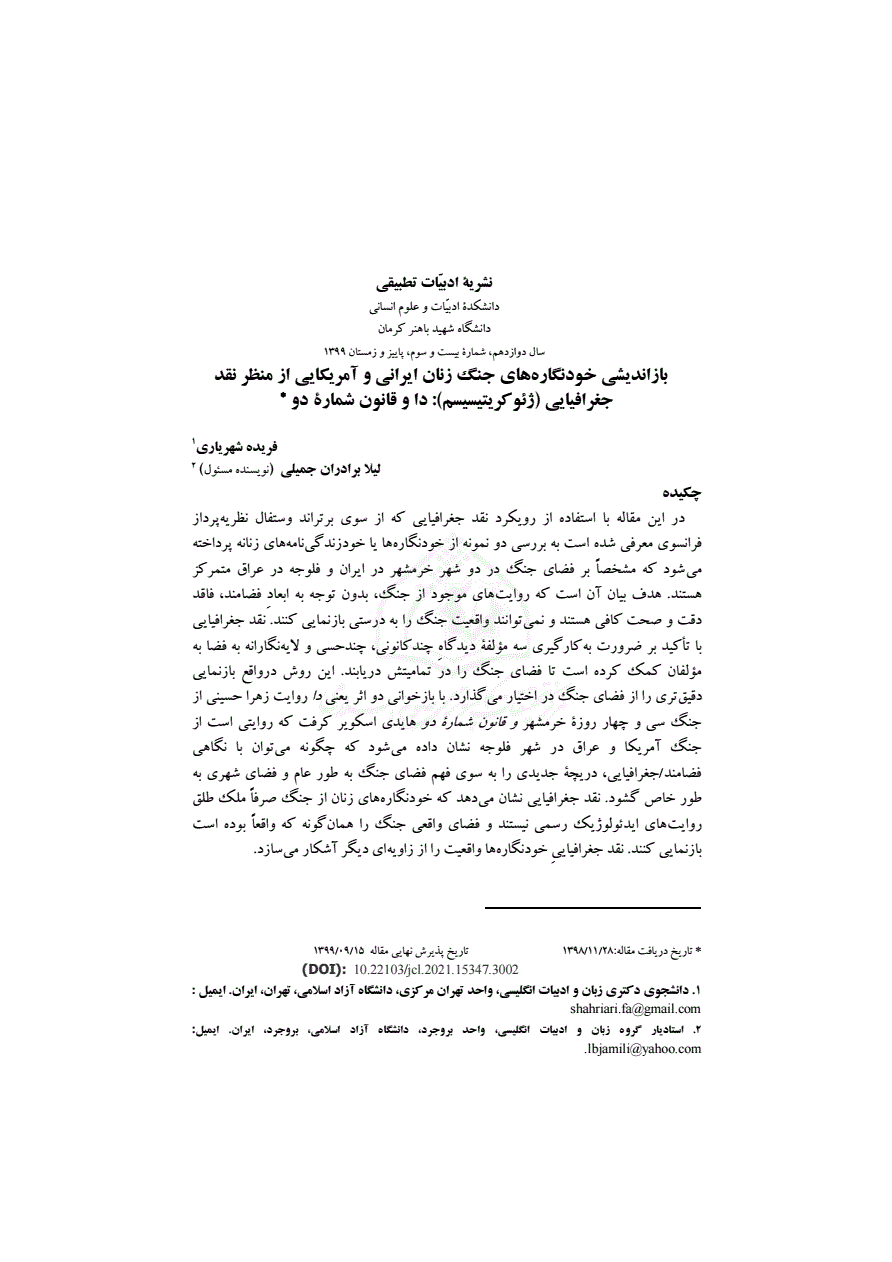چکیده:
در این مقاله با استفاده از رویکرد نقد جغرافیایی که از سوی برتراند وستفال نظریهپرداز فرانسوی معرفی شده است به بررسی دو نمونه از خودنگارهها یا خودزندگینامههای زنانه پرداخته میشود که مشخصاً بر فضای جنگ در دو شهر خرمشهر در ایران و فلوجه در عراق متمرکز هستند. هدف بیان آن است که روایتهای موجود از جنگ، بدون توجه به ابعاد فضامند، فاقد دقت و صحت کافی هستند و نمیتوانند واقعیت جنگ را به درستی بازنمایی کنند. نقد جغرافیایی با تاکید بر ضرورت بهکارگیری سه مولفۀ دیدگاهِ چندکانونی، چندحسی و لایهنگارانه به فضا به مولفان کمک کرده است تا فضای جنگ را در تمامیتش دریابند. این روش در واقع بازنمایی دقیقتری را از فضای جنگ در اختیار میگذارد. با بازخوانی دو اثر یعنی دا روایت زهرا حسینی از جنگ سی و چهار روزۀ خرمشهر و قانون شمارۀ دو هایدی اسکویر کرفت که روایتی است از جنگ آمریکا و عراق در شهر فلوجه نشان داده میشود که چگونه میتوان با نگاهی فضامند/جغرافیایی، دریچۀ جدیدی را به سوی فهم فضای جنگ به طور عام و فضای شهری به طور خاص گشود. نقد جغرافیایی نشان میدهد که خودنگارههای زنان از جنگ صرفاً ملک طلق روایتهای ایدئولوژیک رسمی نیستند و فضای واقعی جنگ را همانگونه که واقعاً بوده است بازنمایی کنند. نقد جغرافیاییِ خودنگارهها واقعیت را از زاویهای دیگر آشکار میسازد.
Leila Baradaran Jamili2 1.Introduction This research employs a comparative study design to analyze the political, sociological, and psychological impacts that Iraq-Iran and Iraq-America war had in shaping the literary and narrative approaches that Iranian and American female war memoirists use. Employing Bertrand Westphal’s approach of geocriticism, this paper examines two female war memoirs that are specifically concentrated on two cities of Khoramshahr in Iran and Fallujah in Iraq: One Woman’s War: Da (2008), narrated by Zahra Hoseyni, and Rule Number Two: Lessons I Learned in a Combat Hospital (2012), written and narrated by Heidi Squier Kraft. This paper aims to demonstrate that the existing and mostly male-centred narratives of Iraq-Iran and US-Iraq wars, due to their aspatial lenses, are unable to represent the reality of war. In other words, existing war narratives are mostly one-dimensional and, therefore, distort the reality of war. The geocritical approach demonstrates that how the spatiality of two mentioned war memoirs is appropriate to go beyond the dominant male-centric narratives. 2. Methodology Geocriticism is a way of perceiving hyperspaces and real spaces, which can be regarded as a new approach in the perception of place in a new sense and altering the conventional ways of recognition. Geocriticism is a method of literary analysis that incorporates the study of geographical spaces which considers all writing as a map. Bertrand Westphal argues that space is more important than time and geography more important than history. Emphasizing the necessity of utilizing three elements of geocriticism namely multifocalization, polysensoriality, and stratigraphic vision, allows the authors to grasp the space of war in its spatio-temporal totality. This method in fact provides us with a more precise representation of war space. 3. Discussion Focusing on two female war narratives, Da and Rule Number Two, a narrative of thirty-four days of Battle of Khoramshahr, and a narrative of US-Iraq war in the city of Fallujah, respectively, it is argued that employing a spatial point of view, one can cast a new light on the understanding of space of war in general, and urban space in particular. Da tells the story of a 17-year-old woman who is ready to die defending her town and the ideals surrounding the Islamic Revolution. The memoir captures the struggles of Iranian women trying to create a balance between the demands of the war on the one hand and their demands as Muslim women especially of how Zahra Hoseyni has called through her memoir, where it serves as an alternative to traditionally male-narrated war literature. The narrator also explains her activities as a combatant in the defense of Khorramshahr, while in the last section, the author devotes to Zahra Hoseyni’s recovery from the shrapnel wounds that she had to bear following the war. The narrator is shown to have spent her married life in two homes where the first one was in the suburban area of southwestern Iran within the commuting distance of the front and the second in the urban apartment house in central parts of Tehran. Hoseyni’s book is a product of time and space, where she carries out interviews with Seyyedeh A’Zam Hoseyni, a woman having the same family name but having no relation to the narrator. The memoir becomes part of the larger project to record the oral histories of Iranian women who actively participated in the Iraq-Iran war. The author presents the map of Khorramshahr both in the form of an image and with the use of literary devices to describe the city as it was during the initial stages of the war based on one found in what Hoseyni calls in her work, Khorramshahr “dar Jang-e Tulani” or Khorramshahr in the Long War. The war, according to the author, rendered the living of a life of comfort meaningless. The war memoir Rule Number Two gives an account of Kraft’s work as a clinical psychologist who uncovers the wounds of war that a surgeon would never see. The doctor puts away the thoughts of her children back at home acclimated to the sound of incoming rockets and learned the ways of listening to the traumatic stories that are offered by a war zone. The narrator shows her audience some of the toughest lessons of her deployment to Iraq, which is articulated by the TV show MASH, where the battlefield is controlled by two rules: Rule number one is that young men die in the battle. Rule number two is that doctors cannot change rule number one. Kraft realizes that some marines and some of their doctors would be damaged by war in ways that she as a doctor would not repair in as much as some people would be repaired in ways she would less expect. The memoir is a powerful firsthand account that gives comfort to those distressed by the war and what it takes to occupy space marked by war. The memoir describes places, people, and events based on the recollection of them to the best memory of the Kraft’s memory’s ability, where she gives the story of all men and women of the Navy and the Marine Corps in Al Anbar, the largest governorate in Iraq. The memoir is a story of the strong men and women who were doing the nation’s bidding so that others would pursue their lives undisturbed. Kraft begins with the story of her life, where after several years as a flight psychologist with the US Navy, she gave birth to twins in 2002. The theory of geocriticism retraces the history and the lines of space, place, mapping, literature, and literary mapping image in literary texts. The researcher examines how landscape and its real and fictional spaces function as a setting for the action in the contemporary life of female memoirists. The landscape, comprising of the real and fictional spaces, becomes the impetus for the texts and its historical backgrounds afforded through the narrative techniques. Three elements of the geocritical approach are employed to provide a comparative analysis of the two mentioned war memoirs: Multifocalization, in which many different points of view are needed to establish the literary space; Polysensoriality, which refers to space inasmuch as it may not be perceived by vision alone, but also by smell, sound, and so on; and Stratigraphic Vision, in which the topos is understood to comprise multiple layers of meaning, deterritorialized and reterritorialized. Through these three steps of inventing new space, women war memoirists try to invent some never seen and unheard partly fictional and partly factual war narratives. The current research is based on the discussion of the narrative techniques of contemporary female war memoirists. The female authors identified as ignored/nonmentioned part of war history who have been forgotten among the gendered masculine face of both literature and history productions. As in the contemporary war studies, gender studies assume the principle concern of war narratives, where the female war memoirists with their unique perceptions of geopolitical and historical backgrounds are producing new literary productions with different narrative techniques. The aim of the present research is to carry out a comprehensive and close analysis of the representation of space and place (and the range of cognition of women memoirists) in the contemporary female war narratives. 4. Conclusion Geocriticism indicates that female war memoirs are not merely the exclusive freehold of official ideological narratives and reflects the real space of war as what it is in itself. Geocritical reading of female war narratives in this manner reveals the reality of war from an entirely new standpoint. It should be noted that three elements of the geocritical approach namely ‘multifocalization’, ‘polysensoriality’, and ‘stratigraphic vision’ are very useful theoretical instruments that enhance our geographical knowledge. They help us to narrate the spaces of war-damaged cities in their multidimensionality. Geocriticism demonstrates that each space is imbued with different sensorial features that are irreducible to each other. Space is a totality of these layers. Spatializing the war narratives (memoirs) is a way to achieve a more precise knowledge of the war.
خلاصه ماشینی:
بازانديشي خودنگاره هاي جنگ زنان ايراني و آمريکايي از منظر نقد جغرافيايي (ژئوکريت سييسم ): دا و قانون شمارٔە دو فريده شهرياري ١ ليلا برادران جميلي (نويسنده مسئول ) ٢ چکيده در اين مقاله با استفاده از رويکرد نقد جغرافيايي که از سوي برتراند وستفال نظريه پرداز فرانسوي معرفي شده است به بررسي دو نمونه از خودنگاره ها يا خودزندگينامه هاي زنانه پرداخته ميشود که مشخصا بر فضاي جنگ در دو شهر خرمشهر در ايران و فلوجه در عراق متمرکز هستند.
با بازخواني دو اثر يعني دا روايت زهرا حسيني از جنگ سي و چهار روزٔە خرمشهر و قانون شمارٔە دو هايدي اسکوير کرفت که روايتي است از جنگ آمريکا و عراق در شهر فلوجه نشان داده ميشود که چگونه ميتوان با نگاهي فضامند/جغرافيايي، دريچۀ جديدي را به سوي فهم فضاي جنگ به طور عام و فضاي شهري به طور خاص گشود.
اهميت اين پژوهش در آن است که خودنگاره نويسان زن با استفاده از نوعي نگاه فضامند سعي کرده اند تا از دريچۀ توصيف جزئيات مکان ها و روابط بين انسان ها و مکان ها و نيز روابط بين خود مکان ها، تصويري دقيق تر از دو شهر خرمشهر و فلوجه در دو جنگ عراق و ايران و نيز آمريکا و عراق ارائه کنند.
خودنگاره نويسي زن ايراني و آمريکايي در اين مقاله ــ دا خاطرات سيده زهرا حسيني، به اهتمام سيده اعظم حسيني، و قانون شمارٔە دو: درس هايي که در بيمارستان جنگي ياد گرفتم اثر هايدي اسکوير کرفت ــ با توصيف تجربيات خود و ديگران از و در جنگ ، به تکنيکي براي بازنمايي فضاي جنگ تبديل شده است .

(پژوهیار,
,
,
)

